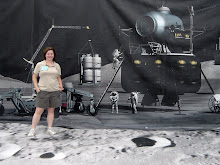While Spirit is stuck in one place for a while, looking at the sky and dirt, I've been paying a lot more attention to Opportunity. Over at Meridiani Planum, we're headed toward this huge (by rover standards) hole in the ground, Victoria crater. Craters over here are named after great ships of exploration, and Victoria was the only ship to successfully return from Magellan's voyage around the world. Victoria crater is just about the size of Meteor Crater here in the southwest, a little less than 1 km wide. Check out the rim of Victoria crater as Opportunity approaches.
Victoria punched a deeper hole into the Meridiani Planum surface than the last big crater Opportunity visited, Endurance crater. Endurance crater was where we got to check out Burns Cliff, a fantastically well-preserved set of sedimentary layers in the inside crater wall that showed crossbedding, evaporite mineral casts, and the little hematite blueberries. Craters are nature's roadcuts, the way these little mechanical geologists will be able to check out what's underneath the surface of the plains, and we're all hoping that the inside walls of Victoria show us more wonders.
Right now, Opportunity is about to roll up onto Victoria's ejecta blanket, which is the apron of material that was thrown out of the crater and rained down around it. When craters form, a lot of stuff gets thrown out from a depth roughly as much as the drater diameter. As the rocks deform and fail with the crater shock, the final crater is much shallower, only about a tenth as deep as the diameter. So, the rocks in the ejecta blanket come from much deeper down than the rocks at the bottom of the crater now. If you want to look for the deepest rocks, you look at the edges of the ejecta, which is what's next on our journey. We're stopping nearly every weekend to check out our surroundings to see if anything is different yet.
It's a little ironic - we're now interested in changes in the rocks but all we see are really large expanses of the same Meridiani Planum bedrock. One of the science team members remarked that last year, huge expanses of crossbedded bedrock would have been nirvana for this rover. But the scientists were so good at eking out the geologic history from what small outcrops they had that now we are just enjoying this area for the ease of driving over lots of flat material.
Friday, May 26, 2006
Tuesday, May 02, 2006
Martian winter work, terrestrial summer work
Spirit is nestled snugly in her Winter Haven and we are all getting in on the chance to conduct experiments that we never seem to have time for when we are on the move. Spirit is parked on the slope of Low Ridge, an arcuate feature that might be connected to, and possibly related to, Home Plate. Directly in front of the rover is an expanse of drifted dust and/or soil, which is the first target of an intense campaign with all the arm instruments to make measurements progressively deeper into the soil. There's also a long list of rock and soil targets for miniTES, some long-timeline atmospheric observations, and a monster panorama of our surroundings in all 13 Pancam filters, which should be really beautiful. For those of us interested in rocks, we have poor choices right now. There are a couple of clasts and possibly a shingle in our workvolume, which we will investigate. Several of us are hoping that after the solstice, we will be able to move to some rock targets ahead of us to figure out the geology of Low Ridge, its relationship to Home Plate, and the origin of some of these volcanic units around us.
In terrestrial analog news, I will be heading to the Ries Crater in Nordlingen, Germany, after the Meteoritical Society meeting this summer. Ries is a well-preserved 24-km diameter, 15 Ma crater with post-impact lacustrine layers inside and fantastic outcrops of ejecta. The Ries ejecta may be a good analog to Martian double-layered ejecta deposits. There is an upper ejecta layer (suevite) which is a mix of deep material and impact melt, overlying a lower layer (the Bunte breccia) which is an interesting unit formed when the first (shallow) ejecta was ballistically emplaced and churned up the substrate, mobilizing it and causing a radial flow. It is rumored there are distal parts of the Bunte breccia containing crossbeds and lapilli that may be potentially interesting to compare with proposed origins of Meridiani and/or layers in the Inner Basin. Cool!
In terrestrial analog news, I will be heading to the Ries Crater in Nordlingen, Germany, after the Meteoritical Society meeting this summer. Ries is a well-preserved 24-km diameter, 15 Ma crater with post-impact lacustrine layers inside and fantastic outcrops of ejecta. The Ries ejecta may be a good analog to Martian double-layered ejecta deposits. There is an upper ejecta layer (suevite) which is a mix of deep material and impact melt, overlying a lower layer (the Bunte breccia) which is an interesting unit formed when the first (shallow) ejecta was ballistically emplaced and churned up the substrate, mobilizing it and causing a radial flow. It is rumored there are distal parts of the Bunte breccia containing crossbeds and lapilli that may be potentially interesting to compare with proposed origins of Meridiani and/or layers in the Inner Basin. Cool!
Subscribe to:
Posts (Atom)
